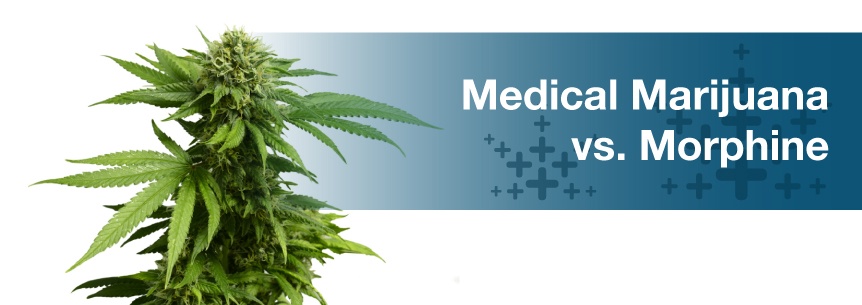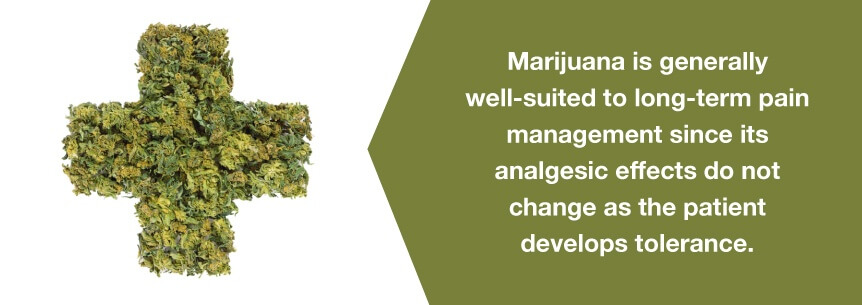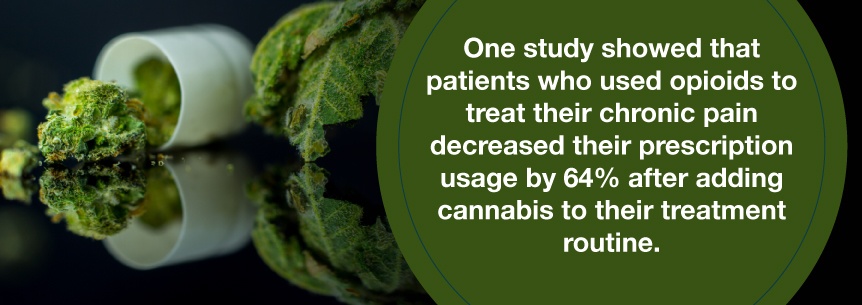
Chronic pain is a widespread concern for Americans, affecting nearly one-quarter of the U.S. population, according to the Centers for Disease Control and Prevention. Despite the prevalence of chronic pain, patients have limited treatment options available. At the moment, prescription opioids like morphine are the most common solution for chronic pain conditions. However, opioid prescriptions come with significant risks, including addiction and overdose. As a result, many patients and doctors are reassessing their usage of opioid painkillers and looking for a new solution.
In the wake of the U.S. opioid epidemic, many doctors and patients have begun supporting alternatives, specifically marijuana. Though marijuana is a Schedule I controlled substance, it presents a more sustainable solution to the issue of chronic pain. Marijuana serves as an effective painkiller and is one of the more popular alternatives to opioid prescriptions. However, it’s still illegal in many states, and many doctors are wary of prescribing it to their patients.
If you suffer from chronic pain and are considering morphine or marijuana as a solution, it’s important that you understand each option. To help, we’ve compiled the facts that you need to know about each substance so that you can make an informed decision.
Morphine has a long history of use in the medical field and has maintained a strong position as a popular painkiller for decades. Morphine is a narcotic, belonging to a family of drugs that work on the brain to depress certain functions. The name reflects this fact, coming from the Greek word narcosis, meaning sleep or stupor. Even though it is less potent than other narcotics like Dilaudid, heroin and oxycodone, morphine is still a powerful drug.

Morphine and other narcotics work on the brain and are typically introduced through the bloodstream. Once absorbed into blood vessels, the veins carry opioid compounds to the brain. Once there, transporters move the compounds to their target cells, where they bind to specific receptors to depress brain functions. One of the effects of this binding is the reduction of pain. As the dosage of the opioid increases, however, the compound may affect other areas of the brain, resulting in the depression of other bodily functions, like respiration.
Over time, the repeated use of opioids like morphine will result in a phenomenon called tolerance, when the brain senses the increased binding rates of opioid receptors and reacts by deactivating and removing them. By doing so, the brain decreases the rate of receptor binding, eliciting a reduced response to the drug. To achieve the same level of pain relief, then, patients have to increase their dosage, which increases the risk of harmful side-effects.
Developing opioid tolerance takes time, so it is primarily an issue for patients with long-term chronic pain. For some patients, tolerance can eventually lead to an overdose.
Over time, the repeated use of opioids like morphine will result in a phenomenon called tolerance, when the brain senses the increased binding rates of opioid receptors and reacts by deactivating and removing them. By doing so, the brain decreases the rate of receptor binding, eliciting a reduced response to the drug. To achieve the same level of pain relief, then, patients have to increase their dosage, which increases the risk of harmful side-effects.
Developing opioid tolerance takes time, so it is primarily an issue for patients with long-term chronic pain. For some patients, tolerance can eventually lead to an overdose.
As a painkilling drug, morphine is highly effective and fast-acting, offering the following benefits as a painkiller:
On the other hand, Morphine does elicit some adverse effects, including:
Marijuana has been used across various cultures as a form of medicine for over 5,000 years. Unlike morphine, which was historically used as strong analgesia, marijuana was used in the treatment of over 200 diseases, including many painful conditions. The most common use of marijuana was as a treatment for headaches.
Despite its utility and extensive use throughout history, marijuana usage was criminalized in 1942 in the United States. By classifying marijuana as a Schedule I drug, the U.S. government removed cannabis from the pharmacopeia. While there is currently a push for cannabis legalization, as of now, only 34 states and the District of Columbia have legalized medical marijuana use. The law has proven to be a hindrance to the reintroduction of marijuana to the medical community, as it has stifled research and introduced a stigma to cannabis usage.
As a painkiller, marijuana works on the brain through a slightly different pathway than morphine. When introduced into the bloodstream through inhalation or ingestion, the compounds in marijuana travel to the brain and are transported to cannabinoid receptors throughout the brain. However, instead of depressing brain functions like morphine does, marijuana elicits a state of euphoria.
There are two medically essential compounds in marijuana: THC and CBD. THC, or tetrahydrocannabinol, is the primary psychoactive component in marijuana, affecting specific receptors in the brain to produce a euphoric effect. In addition to this, THC also delivers pain relief and reduced inflammation. CBD, or cannabidiol, on the other hand, is minimally psychoactive but medicinally important, acting as an antidepressant.
Like with morphine, tolerance is an issue with cannabis, though not to the same extent. Patients may develop psychological tolerance to cannabis, and their feeling of euphoria may decrease, but there is currently no research to suggest that this tolerance reduces the analgesic effects of marijuana. That being said, habitual users may experience withdrawal if they abruptly decrease or stop marijuana usage, though this issue rarely affects patients using lower doses.
Marijuana may offer the following benefits as a painkiller:

On the other hand, pot does elicit some adverse effects, including:
Ultimately, marijuana and morphine are two entirely different substances that affect the brain in unique ways. When compared side-by-side, patients must consider the following:

In short, while marijuana presents impressive potential as a medically viable drug, its status as a Schedule I controlled substance at the federal level is hindering its use and prescription, even in states where medical marijuana is legal. With the current push toward legalization and increased education about medical cannabis, however, marijuana supporters are optimistic that medical marijuana as a painkiller will become accepted in the medical world and achieve more universal regulation and standardization.
Marijuana and morphine don’t have to be used exclusively — because marijuana works through a different mechanism than opiates, it can be used in conjunction with a morphine prescription. This combination not only helps patients improve pain levels but also reduces the amount of morphine needed to maintain patient comfort. It’s important to review your options with your healthcare provider before self-dosing.
One study showed that patients who used opioids to treat their chronic pain decreased their prescription usage by 64 percent after adding cannabis to their treatment routine. The same study also reported general quality of life improvements in these patients, including a decrease in side effects.

Physicians can start patients off right away with both morphine and cannabis, or introduce marijuana to a patient’s treatment plan after using opioids for a while. If a patient is currently using opioids, physicians tend to recommend caution when adding cannabis to their treatment plan.
Patients should not attempt to combine these two drugs on their own and should only do so under the careful guidance of a medical professional, which helps mitigate side effects and prevent accidental overdoses. Most doctors recommend weaning off opioids before introducing marijuana, but marijuana can be introduced earlier to minimize the effects of opioid withdrawal.
With the opioid epidemic continuing to pose a problem, finding and developing alternatives must become a priority. Even though it’s a viable solution, marijuana is currently in the very early stages of its medical use, which poses many challenges for physicians and patients wanting to use it in their treatment plans. If you’re interested in adding medical marijuana to your treatment plan, it’s best to work with a trusted doctor who is up to date on the latest medical marijuana research.
No Information on MarijuanaDoctors.Com should be used to diagnose, treat, prevent or cure any disease or condition. You can view our Full Disclaimer here.